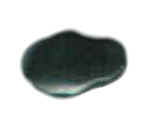|
HELIOTROPE
|
 |
A semi-precious variety of chalcedony (a form of quartz) which is a member of the oxide group. It is also known as bloodstone due to distinctive red spots apparent on it's green surface. The green colouring is due to inclusions of the minerals attinolite and celadonite and the red spots due to iron oxide impurities which have the same chemical composition as jasper. The pattern and intensity of the red spots influence it's commercial value. It is relatively hard (7 on the mohs scale).
It's name is derived from the Greek word helios which means sun. In ancient times some people believed that the red spots came from the sun and heliotrope was said to give the owner the power of invisibility. Today it is used mainly for ornaments and small statues.
It forms when silica is deposited by hot water (hydrorthermals) in the cavities within iron bearing volcanic rocks. It forms in slabs made up of aggregates of quartz crystals. It may also form by the precipitation of silica from salt water (iron ore deposits must be nearby).
In ancient times it was found in Cyprus and Ethiopia. Now it may also be found in India, Australia, Austria, Brazil and US.
A silicate and member of the garnet group which is hard and glassy in appearance. It is a brown, orange or yellow variety of grossular garnet and is also known a cinnamon stone due to its colour. Essential components include calcium, aluminium, silicon and oxygen. It derives its colour from particles of iron and manganese which are impurities or inclusions and not part of the chemical composition. All garnets have a complex chemical make-up. Metals often swap places with each other which is known as continuous atomic substitution. Hessonite appears to be transparent but on close examination alternating dark and light layers can be identified, which give it a treacley appearance. This is a unique characteristic
Hessonite is fairly hard (6.5-7 on the mohs scale) and the most valuable specimens are faceted into opal shapes. Resilience may be improved by heating and then cooling very quickly. Less precious specimens are sometimes polished and used for jewellery. The oldest known surviving specimens of heliotrope are in brooches made in Sri Lanka in the 2nd century BC.
It is similar in appearance to zircon, in fact for many years they were considered to be the same mineral and were known as hyacinth or jacinth. They can be differentiated because zircon can split light into 2 distinct beams (a characteristic known as birefringence). Zircon is not a garnet and does not even have the same crystal system as heliotrope.
Hessonites closest relatives are andradite and uvarovite. Its name is derived from the Greek word hesson, which means inferior (it is considered to be less precious than zircon). As with most grossular garnets it forms by contact metamorphism and only in localised deposits. It tends to form in clumps and often in metamorphic rock, particularly serpentines. Striations may be evident on its surface.
Finest specimens can be found in Sri Lanka but it can also be found in Quebec (Canada), Mexico and California (US).
